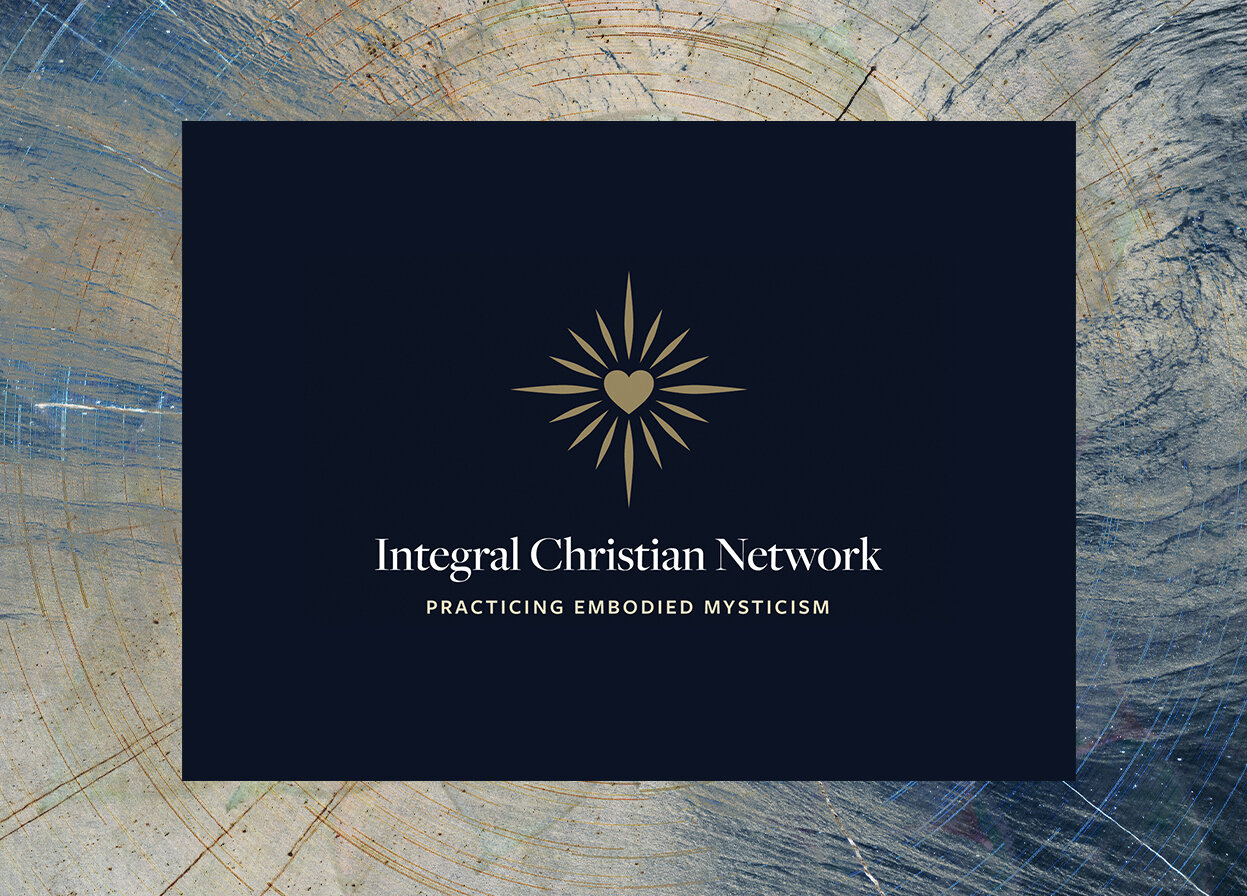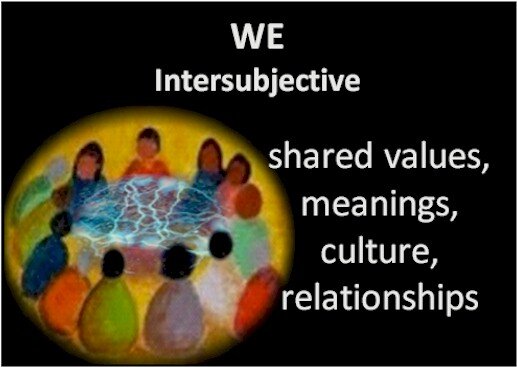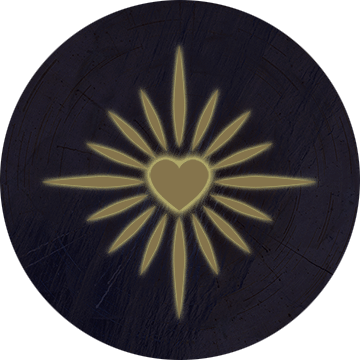What's in a Logo?
Six Symbols to Live By
Our thanks to graphic designer and WeSpacer, Christy Thrasher, for designing this brilliant logo for us at Integral Christian Network, and for a beautiful redesign unfolding on our website now. The logo symbol points to six dimensions that are central to our practice and understanding.
1. The Heart Hub
The center of our logo is a heart, the vibrant, glowing hub of the Integral Christian Network. We understand and experience that God is love, and Jesus taught love as the greatest of all directions in life.
Jesus began his list of the most important things with “Love God with all your heart” According to the Theological Dictionary of the New Testament, the Greek word “heart” (καρδιά) is the center of one’s inner being and includes desires, emotions, understanding, and will. Jesus then added, “with all your soul,” which is one’s life, especially feelings, desires, affections, “with all your strength,” which is our ability and capacity, and “with all your mind,” which is our mental understanding (Luke 10:27). That list sounds very integral! This list also pushes back at those who talk about love not being “mere emotions and sentimentality but good thinking and right action.” How about all of the above!
2. The Four Large Beams Form a Cross
The four large beams represent the cross, the traditional symbol for Christianity. The cross represents Jesus’ self-giving love as he faced death for speaking the truth to the religious and political authorities of his day. In an inner dimension, it portrays the drama of what Jesus called “losing our life to save our life.” This is dying to our identification with our constructed self so that we can identify with our divine self, our True Self.
An integral understanding of the cross transcends the idea that Jesus died to pay God for our sins. One of my favorite theologians, Marcus Borg, in Speaking Christian about the cross, says, “The most widespread Christian understanding today is that Jesus paid the price for our sins by dying in our place. In theological language, this is called substitutionary sacrifice, substitutionary atonement, or sometimes the satisfaction understanding of Jesus’s death. Jesus is the substitute who satisfied God’s wrath by undergoing the punishment that we all deserve.”
This distorts Christianity, turning it into the widespread notion that Christianity is mostly about sin, forgiveness, and going to heaven and avoiding hell. But what if that is not what Christianity is all about? What if Christianity is about transformation—our transformation and that of the world? Yes, there is death involved, the dying of our attachment to our ego. This then allows our Christ Self, our divine self, to emerge. As Paul puts it, “I have been crucified with Christ; and it is no longer I who live, but it is Christ who lives in me” (Gal. 2:19–20). Our ego death and resurrection of our deepest divine self is what the cross and resurrection are all about for us personally and globally. The more others find this new life, the greater the collective of those who are awakened to this new, transformed, mystical life.
3. The Four Large Beams Outline Integral’s Four Quadrants
One of the foundational premises of integral understanding is that there are four dimensions of reality that are present in every moment and on every occasion. These dimensions are actual aspects of the world, four perspectives that must be consulted when attempting to fully understand any issue or aspect of reality. These are helpfully pictured as a diagram with four quadrants. This is commonly called “the four quadrants” in integral-speak. Here they are:
Integral’s Four Perspectives in WeSpace Imagery
Upper Left Quadrant — Interior Individual “I” Space
This represents your subjective, individual, interior “I” dimension. You experience this perspective when you focus your attention inward and ask yourself, “What am I aware of in myself right now?” This is the world of your inner consciousness, from sensations, to feelings, thoughts, memories, dreams, intentions, intuitions, perceptions, and sense of beauty—in other words, our “I” space. It is how we make sense of our experience of the world.
This is the inner space we go into in the individual Whole-Body Mystical Awakening Practice and other meditative prayer practices.
Lower Left Quadrant — Interior Collective “We” Space
This represents the intersubjective, the world of our collective, interior experiences: our shared values, meanings, language, relationships, and cultural background—in other words, our “we” space. You experience this dimension when you focus your attention outward and ask yourself, “How do I relate to others, and how do they affect my awareness?” This includes everything you have learned through your culture, such as language, religious beliefs, worldviews, moral values, commitments, humility, empathy, compassion, devotion, and faith.
This is the collective space we bring into more conscious awareness and even mystical participation with others in our WeSpace group.
Upper Right Quadrant Exterior Individual “IT” Space
This quadrant represents your objective individual exterior, physical “it” dimension that can be observed by you or anyone else. It includes your sex, skin, muscles, cells, hormones, enzymes, brain structures, smell, voice, height, and size. Behaviors such as physical exercise, body language, and emotional outbursts fall into the UR quadrant.
In the objective—or upper-right—quadrant, we find the world of the individual, exterior things: our material body (including the brain) and anything that you can see or touch (or observe scientifically) in time and space—in other words, our “it” space. In a WeSpace meeting, it is our physical bodies, our computer and its Zoom program, as well as our own subtle and causal bodies.
Lower Right (LR) quadrant Exterior Collective “Its” space
This represents your collective exterior (social) “its“ dimension. You experience this dimension when you focus your attention on the physical world around you and ask yourself, “what is the social, economic, and ecological environment that sustains my body?” This includes the air that you breathe, the food that you eat, shelter, possessions, occupation, financial assets/liabilities, social status, physical relationships, and other systems of collective structures.
Why do I need to know about any of this?
There is the possibility, of course, that you don’t. It is a little “heady” and takes some reflection to get it. I have found it helpful in two ways.
One is called “quadrant absolutism.” Sometimes people take the position that only the phenomena in one or two of the quadrants are ultimately “real” and that all phenomena in the other two or three quadrants are derived from the one or two quadrants they consider “real.” For example:
When scientists assert that all reality is reducible to nothing but objective matter (for example, the assertion that consciousness is entirely reducible to brain cells and chemistry), they are reducing all quadrants to the upper and/or lower right quadrants.
When some new age authors claim that my individual interior thoughts create the entire physical world, they are reducing all quadrants to the upper left.
When extreme post-modernists assert that “all knowledge is nothing but a cultural construction,” or that “all values and worldviews are equal, and we cannot judge any of them against another,” they are reducing all quadrants to the lower left.
4. The Sets of Three Lines Symbolize the Three Faces of God.
For me, the really big takeaway of the four quadrants is the Three Faces of God. If we collapse the right side of IT and ITS into one big IT, we end up with what Wilber calls the Big Three and the Three Faces of Spirit. This is the ‘I” face, the “We” face, and the “It” face of God.
The “I” face of God is our own inner divinity, the inner face of God being us.
The “We” face of God is our personal relationship to the intimate face of God beside us. This is found in many forms. For Jesus and later on his followers, it is first of all the motherly fatherly face of God that Jesus called “Abba.” Then after the resurrection, it became Jesus’ presence itself, communicating God’s reality to us in a transforming friendship. Paul then expands Jesus into the Cosmic Christ, which is the Christian symbol for everything. This means other people can be the presence of God to us. Nature can be the presence of God to us. The cosmos itself can be the presence of God to us.
The “It” face of God is the infinite face of God beyond us. While graphically image this as the infinite cosmos, God is even beyond that. This is God as Infinite Being itself, not a being as in the “We” face of God. This is God as Infinite Consciousness, the One Consciousness of which we are a part.
Many spiritual and religious traditions emphasize one or two of these faces and dismiss the others. Like the four quadrants, we need all three of the faces of God to get an integrated picture of a God who is being us, beside us, and beyond us.
5. All the Lines Moving In Toward the Heart Hub Represent our Coming Together in a WeSpace Collective within the Integral Christian Network.
So much spiritual practice in the Western World is conceived of as individual practice. Even when done in a group setting, the collective tends to be ignored. ICN aims to rebalance that by demonstrating the transforming power of the collective field of spiritual energy.
This happens as small groups come together to foster mutual, loving relationships while practicing meditative prayer together. We gather in larger groups in the name of Jesus, such the ICN Sunday morning “church” group does. These and other forms of “coming together” fill our hearts with love in the experiential communion of support and mutuality. They strengthen our experienced reality of the oneness at the heart of all things.
These collectives also create a transforming field which is transmitted to the participants as well as radiating out to the world, which brings us to our last point.
6. All the Lines Radiating Out Signify the Collective Energy Field of ICN Transmitting Transforming Love to the World
There is a powerful form of social activism that changes the world merely by those on a transforming spiritual path coming together and radiating love from awakened consciousness to one another and the world.
In Subtle Activism: The Inner Dimension of Social and Planetary Transformation, David Nicol says that as a kind of quantum event, the consciousness of spiritual practitioners involved in very subtle dimensions of reality is co-creating certain forms of awareness and thought. This makes those forms more accessible to collective levels of human consciousness.
We believe Integral Prayer is social action. Jesus said in Matthew 18, “Whatever you bind on earth will be bound in heaven and whatever you loose on earth will be loosed in heaven.” The early Christians joined together constantly in prayer as the principal method to support and implement their world-transforming mission.
Despite the appearance of separateness, there is a unified field that underlies both the human mind and the natural world. The discovery of nonlocality suggests that the entire universe may be a vast web of particles that remain immediately and instantly interconnected at a fundamental level. Powerful forms of spiritual practice can themselves subtly effect change in the social realm through this principle of nonlocal causality in the unified field.
Mystical activism is not meant to replace direct activism but rather work together with it in ways that help activists to operate from their Christ selves and with ever-renewing inner resources.
A genuinely cosmic perspective means we see ourselves first and foremost not just as members of the human family but as earth beings in interdependent relationship with all the human and nonhuman members of the cosmic family.
We’ll be writing more about this in the coming weeks.
Logo and design created and donated by Christy Thrasher
Nebraska native Christy Thrasher is a graphic designer and brand strategist behind award-winning campaigns for established luxury brands who has worked closely with acclaimed firms for projects around the globe. As head of her own Los Angeles-based studio, she specializes in developing brand identities, collateral, packaging, and environmental signage. Working at the intersection of art and business, Thrasher takes pride in enabling harmony, producing tailored designs intended to heighten both physical beauty and a unique sense of space.
Christy Thrasher
@thrasherdesign
+1 310 696 1226













